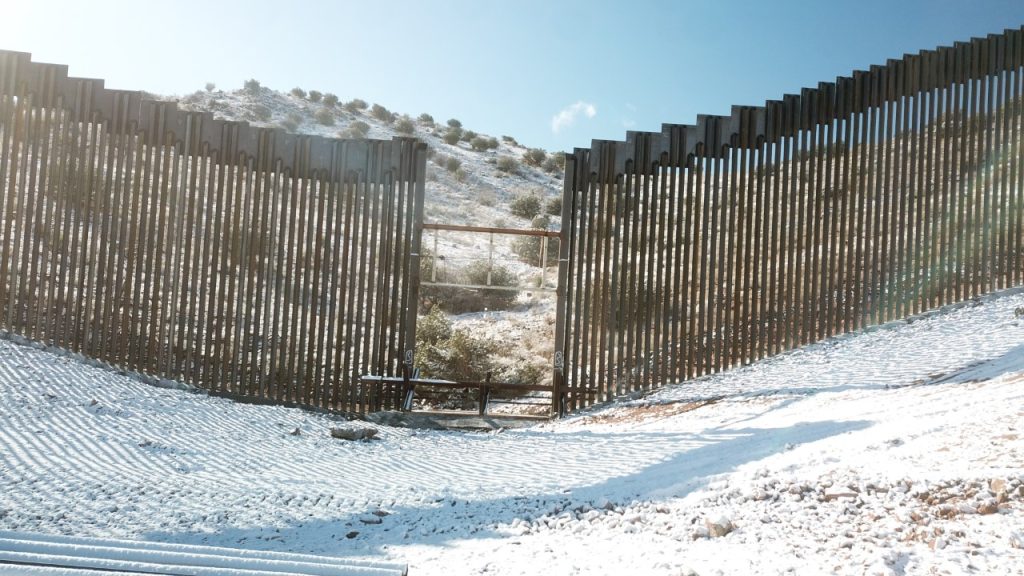Challenges on the Border
The heavy presence of illegal immigrants has long been an issue in the Southwest region.
Erica Valdez and her husband ranch near Animas, a little town in the southwest corner of New Mexico. Valdez’s mother bought the 64 section ranch in 1995 when Erica was in high school. The ranch sits 20-40 miles away from the Mexican border. Neighbors are few and far between in their area. Instead of hiring outside help, they mostly trade labor with other families who have kids. Most of their help has been girls under the age of 16.
The type of traffic coming across the border has drastically changed since Valdez was a child. Families crossing for a better life in America were once the norm; people were mainly looking for food, water and work. Now, heavily armed men, wearing camouflage and carrying backpacks full of drugs have taken the place of families. The climate is better in the south for growing marijuana, cocaine and opium. Even now with marijuana being legal and having dispensaries in the U.S., mostly harder drugs are being imported by the cartel. Some travelers are even human traffickers smuggling people in and out of the country.
Many times through the years, while riding through cattle horseback Valdez has stumbled upon men in camo and dark masks, fortunately without incident. The family is concerned for their teenage daughter’s safety, but “we can’t not do the work we need to do because of it,” Valdez said. “We are smart about it.”
On occasion, Valdez has carried a pistol and hired men have packed rifles for protection. She doesn’t do this frequently anymore, as to not make the migrants feel threatened, or fear retaliation. She acknowledges it opens up too much room for misconception and doesn’t want them to feel she would be aggressive. If the illegals feel threatened, they could become reactive and dangerous. She usually nods, and rides on by.
In 2021 while out prowling through cattle alone, Valdez came upon four men huddled together under a juniper tree. The next day, there was no sign of them, no tracks, and no broken tree limbs. There was not one trace they had even been there. However, she found a spotters camp on a slope nearby. This was a place for a lookout being manned by someone using high-tech optics and radio, staying in contact with drug runners, while keeping an eye on all roads leading to the highway from a superior vantage point.
The New Mexico/Mexico border is 181 miles long. In April of 2020, during the first Trump Administration, the building of the wall began. The wall only covers 103 of those miles. Construction was shut down by the Biden Administration in March of 2021, and there are “funnels” in which people can travel back and forth. The wall was never finished and there are gaps. There is barbed wire fencing in some places where there are voids, but they are easily cut and driven across.
Illegals have no respect for property. They cut fences, leave trash, drain water lines to get a drink, break into outhouses, steal vehicles and enter barns and outbuildings, sometimes even family homes.
When the border patrol focuses on one spot, illegals change locations. The smugglers and drug cartels are smart. They know where they are at and whose land they are on. They have done their research and have picked specific trails for a reason. They try to run over the wall, tunnel under it, and even drag it out of the way. Land owners are responsible for repairs in their own fencing.
“Money for building the wall could have been spent on better equipment, more ATV units, horse patrol units and more man power,” Valdez said. She believes “the wall does slow down human smuggling, but the drug industry is a multi-billion dollar industry and they’ll find a way to get in. Humans on the border are needed most of all.”
As the second Trump Administration begins, there has already been a reduction in traffic. Valdez said border patrol is telling her they aren’t tracking anyone as far north as the highway, because, for the first time, agents were ordered to patrol the actual border, not just the highways north of the border. Now they are catching the illegals coming across.
The cartels have gotten pretty reactive to Trump and the military presence on the border. There are occasional bombings, and the border towns are not safe anymore because of retaliation. The Valdez family used to enjoy crossing the border, taking friends out to eat, and spending the day shopping, but they’ve been advised now not to cross. Valdez said this is not really being covered by the news, but the cartels are also placing IEDs (Improvised Explosive Devices) along the border and targeting border patrol agents. “It’s tragic,” she said. Locals assume Trump will finish the wall, but no one is hearing anything on bids or contracts as of yet.
Amanda Adame is the fourth generation on the Flying W Ranch in southern New Mexico. Their closest town is 55 miles away, their nearest neighbor, six miles, law enforcement takes an hour to get to them, and the ranch sits eight miles from the border. Her family has been ranching on this land since 1912. Adame said her family always gave the immigrants food, water and a little traveling money on their way to a bigger town. “They would be humble and thankful,” she said.
But the type of person that comes across the border from Mexico is changing, Adame said. In years past, the family would help and send them on their way; now they find men and women who are hiding. “They don’t want to be stopped, and will get to where they want to go through any means possible. Sometimes they can’t walk any farther, so they’re forced to stop at the ranch. Some people want to use the ranch’s internet so they can call a ride.”
Adame’s family gives them aid and supplies to doctor their feet before they head north again. “Sometimes when you see a group of them under a bush or something, you don’t know if you should even act like you saw them,” she said. People will stop anywhere they can. They have left spigots open after helping themselves to drinking water, draining four thousand gallon water tanks on the ranch and leaving cattle and wildlife without water. Sometimes they cut fences, leaving cattle to wander and get lost in another pasture without water.
Mostly 25-45 year old men are coming across, Adame said. “They are strong, aggressive, demanding, and a little scary. They are in great shape and dressed in black or military camouflage. They aren’t worried about being picked up once their jobs are done, they’re looking for a ride back to Mexico. The biggest threat, though, is who they are and what they’re bringing across.”
During the Biden Administration, Border Patrol dissipated because of the multitude coming across. “Having to arrest each one and take them in for processing left fewer and fewer agents on the border,” she said. Adame remembers that during President Trump’s first administration, when they were working on the wall, traffic almost stopped with the construction going on and the presence of the engineers and wall crews. “They won’t come through where Americans are present,” she said.
While there are risks that come with living on the border, agriculture is Valdez and Adame’s way of life. Generations have sacrificed through the years to keep their ranches functioning and in their families. Adame said real estate value South of I-10 dropped during Biden’s term in office because of the lack of border security.
Russell and Brandy Johnson live just outside the village of Columbus in Luna County, New Mexico, bordering Chihuahua, Mexico. Also fourth generation ranchers, they share a little over eight miles of the border with the southern country. Their ranch has been in the family since 1918. Johnson said it was “a complete free-for-all under the Biden Administration.” Illegal aliens break fences between ranches and cattle get mixed.
“Neighbors may have different breeds, different management practices and vaccination programs,” John son said. “When water systems aren’t working properly due to illegal aliens filling water jugs, or when the traffic around the livestock tanks keep cattle from drinking, over time, this can cause stress induced illnesses like Pasteurella pneumonia, and increase the risk of death loss.”
Johnson said people crossing the border wear carpeted booties over their shoes to conceal tracks.
“Driving migrants to the highway is against the law, and dangerous. Most of them now are coyotes, drug runners, or spotters. There is an unspoken agreement; if they don’t come to the house and bother us, they get left alone. Family units coming in head to Kansas, Nebraska, the East Coast and the West Coast, to get as far away from the border as possible. The cartel will go back to Mexico for their next drug run.”
When Biden signed the executive order during his term to halt the building of the wall, and promising a more empathetic approach to immigration, Johnson noticed an increase in traffic. Johnsons have young children, and believe “it is a danger for anyone to be alone. There is lack of cell phone service on places of the ranch, and a language barrier with the illegals.” The material for building the wall during Trump’s first term was left right where they paused, leaving a three-quarter mile gap, ready to be resumed.
Just one day after Trump took office, January 21, 2025, Johnsons started seeing more border patrol helicopters, air marine operations, and the air wing of customs. “It was a night and day difference.”
There has been a dramatic shift in traffic purely by enforcing the laws. Encounters of illegal aliens at the southern border have sharply declined since President Trump’s inauguration, according to Customs and Border Protection data, falling from 96,036 in December to 61,447 in January, and down to 11,709 by February. The drugs however, are staying steady, and with the increased security, the Mexican Cartel is a little more, “brazen” trying to get drugs across.
Johnson would like to see more officers along the wall, and hopes the unfinished parts of the wall on his ranch will be completed. He hopes the government can fix the broken immigration system and border issues. “There’s definitely a hardship leaving a ‘funnel’ on our ranch, but we won’t give up our 100 year legacy out here,” he said. With Biden in office, area residents felt like the door was wide open. Under the new Trump administration, just in the last three months, “Things are changing quickly at the border,” Johnson said. “Illegals are fearful of Trump, because he’s delivering what he’s promising, but having a wall is still an absolute necessity. Trump won’t always be in office, he will term out, and you’re not always going to have [someone in office] that’s going to be as strong on immigration. We need some sort of infrastructure to keep illegal activity at bay.”
When migrants cross, they generally go one of two ways: those in civilian clothes go west, looking for officers to shuttle them to processing centers to request asylum, and those in dark colors carrying backpacks head North. They choose grueling terrain through mesquite trees and shrubs and avoid highways and roads to prevent being caught.
Many ranchers keep rifles at their front doors, and pistols in their vehicles for self defense. In the past, immigrants have been an asset to the U.S. and a very important part of our country historically. We can welcome them in legally. Border Patrol agents are happy to be back in the field, though they feel they have a lot of territory to take back from the cartel.
Mexican cartels have also smuggled drugs into the United States for years inside cattle. They are known to be very creative thinkers, and anything is possible.
In the southeast corner of Arizona Ed Ashurst lives on a large ranch 35 miles east of Douglas, a place he’s called home for 30 years. His house sits 20 miles north of the border and seven miles from the New Mexico border. He manages the ranch, taking care of 1,000 cows. Ashurst believes border patrol, under Biden, basically collapsed into non existence.
While he knows he’s painfully over-opinionated, Ashurst said during President Trump’s first term he didn’t feel like they needed the wall.
“The wall was very controversial among cattle ranchers, some wanted the wall, some did not,” he said. “What most people don’t know, is that the border patrol is not, and never has been, on the border itself. The border patrol is 10-15 miles north of the border, a planned strategy mainly designed by a guy named David Aguilar who was head of border patrol under Bill Clinton around 30 years ago. Since Trump took office, the illegal traffic coming across has dropped 90-95% almost overnight. Traffic is a fraction of what it was and the lowest it’s been in probably 60-70 years.”
It has nothing to do with the border patrol, Ashurst claims. “Under Biden, manpower dropped. President Trump is prosecuting illegals, sending them back, and cutting off any government benefits, and for that reason, a lot of them are leaving the U.S. and going back to Mexico on their own. Trump’s policies are in place and he is upholding the law, arresting and deporting aliens. Not as many are coming now, other than the cartel. They see a very bleak future here under Trump.”
While Ashurst is a Trump supporter, he said “the concept of building a wall from the Gulf of Mexico to the Pacific Ocean is ludicrous. But the wall in places is probably a good thing, it has slowed the flow of traffic.” He’s certain there needs to be law enforcement at the wall, because people will still try to get through, or climb over.
Ashurst’s good friend, John Ladd, has a cattle ranch in California with ten miles of international boundary. On the southeast corner of the ranch sits a little border town called Naco. There is a huge new border patrol station right there. Ladd and Ashurst both credit President Trump for reducing the flow of migrants crossing Ladd’s property. Ladd has part of the first wall ever built on his land: “the best wall” Ashurst said, “and never, under any administration has traffic ever slowed down across his property until January.” Hundreds of migrants crossed Ladd’s property every day. Eighteen dead bodies were found through the years on his 16,400 acre spread, and in 2002 he came home to a migrant sitting in his living room.
“The illegals are now terrified and they know Trump means business and is making good on his promises,” Ladd said.































